2006 LAND ROVER FRELANDER 2 lock
[x] Cancel search: lockPage 232 of 3229
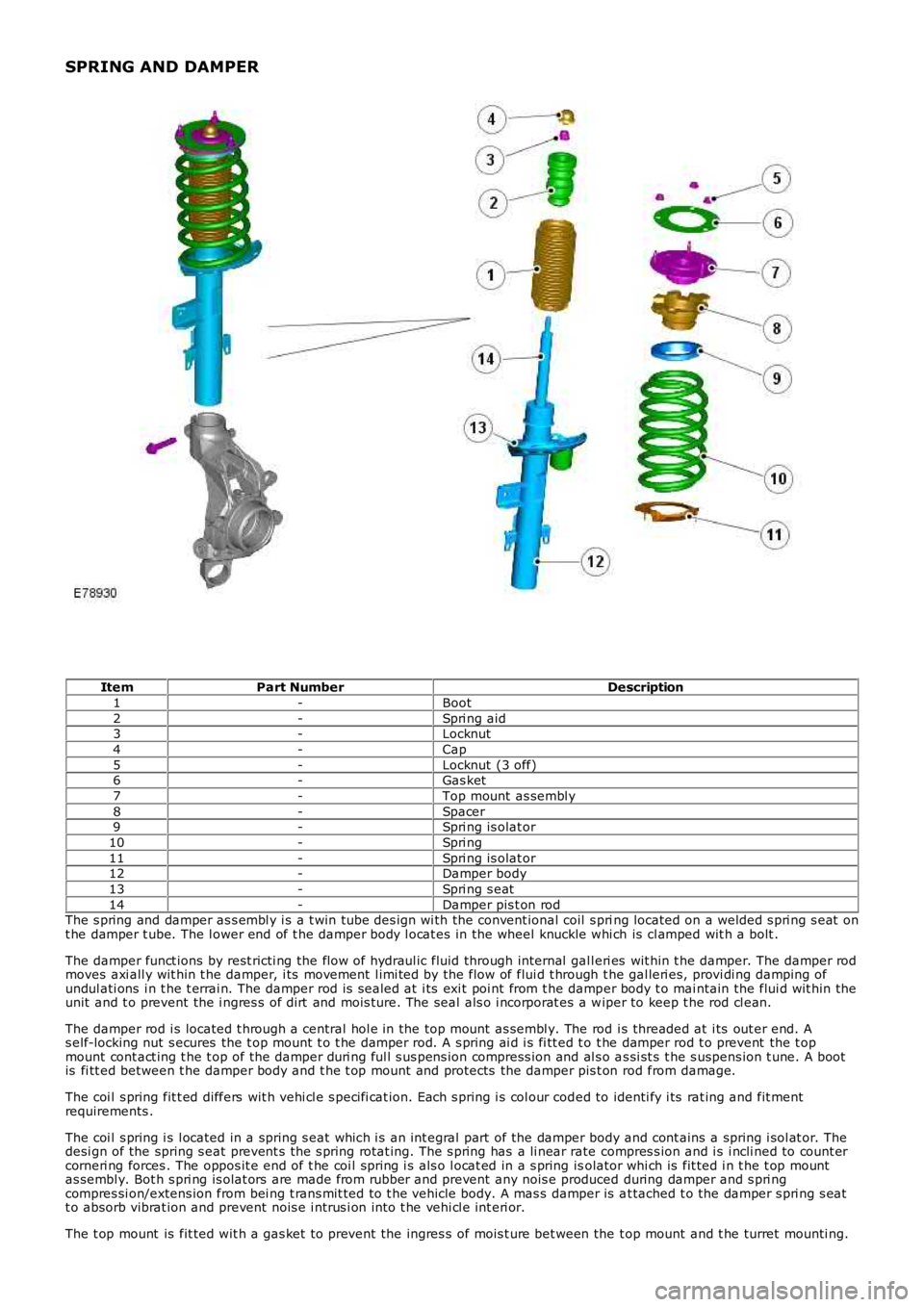
SPRING AND DAMPER
ItemPart NumberDescription
1-Boot
2-Spri ng aid3-Locknut
4-Cap
5-Locknut (3 off)6-Gas ket
7-Top mount as sembl y
8-Spacer9-Spri ng is olat or
10-Spri ng
11-Spri ng is olat or12-Damper body
13-Spri ng s eat
14-Damper pis t on rodThe s pring and damper as s embl y i s a t win tube des ign wi th the convent ional coil s pring located on a welded s pri ng s eat ont he damper t ube. The l ower end of t he damper body l ocat es in the wheel knuckle whi ch is cl amped wit h a bolt .
The damper funct ions by rest ricti ng the flow of hydraul ic fluid through internal gall eri es wit hin t he damper. The damper rodmoves axi all y wit hin t he damper, i ts movement l imi ted by the flow of flui d t hrough the gal leri es, provi di ng damping ofundul ati ons i n t he t errai n. The damper rod is s ealed at i ts exi t poi nt from t he damper body t o mai ntain the flui d wit hin theunit and t o prevent the i ngres s of dirt and mois ture. The seal als o i ncorporat es a wiper to keep t he rod cl ean.
The damper rod i s located t hrough a central hol e in the top mount as sembl y. The rod i s threaded at i ts out er end. As elf-locking nut s ecures the t op mount t o t he damper rod. A s pring ai d i s fi tt ed t o t he damper rod t o prevent the t opmount cont act ing t he t op of the damper duri ng ful l s us pens ion compress ion and al s o as si st s t he s uspens ion t une. A bootis fi tt ed between t he damper body and t he t op mount and protects the damper pis t on rod from damage.
The coi l s pring fit t ed differs wit h vehi cl e s peci fi cat ion. Each s pring i s col our coded to identi fy i ts rat ing and fit mentrequirements .
The coi l s pring i s l ocated in a spring s eat which i s an int egral part of the damper body and cont ains a spring i sol at or. Thedesi gn of the spring s eat prevent s t he s pring rotat ing. The s pring has a li near rate compres s ion and i s i ncli ned to count ercorneri ng forces . The oppos it e end of t he coi l spring i s als o l ocat ed in a s pring isolator whi ch is fit ted i n t he t op mountas sembl y. Bot h s pri ng is olat ors are made from rubber and prevent any nois e produced during damper and s pri ngcompres si on/extens ion from bei ng t rans mit ted to t he vehicle body. A mas s damper is at tached t o the damper s pri ng s eatt o absorb vibrat ion and prevent nois e i ntrus i on int o t he vehi cl e int eri or.
The t op mount is fit ted wit h a gas ket t o prevent the ingres s of mois t ure bet ween the t op mount and t he turret mounti ng.
Page 233 of 3229
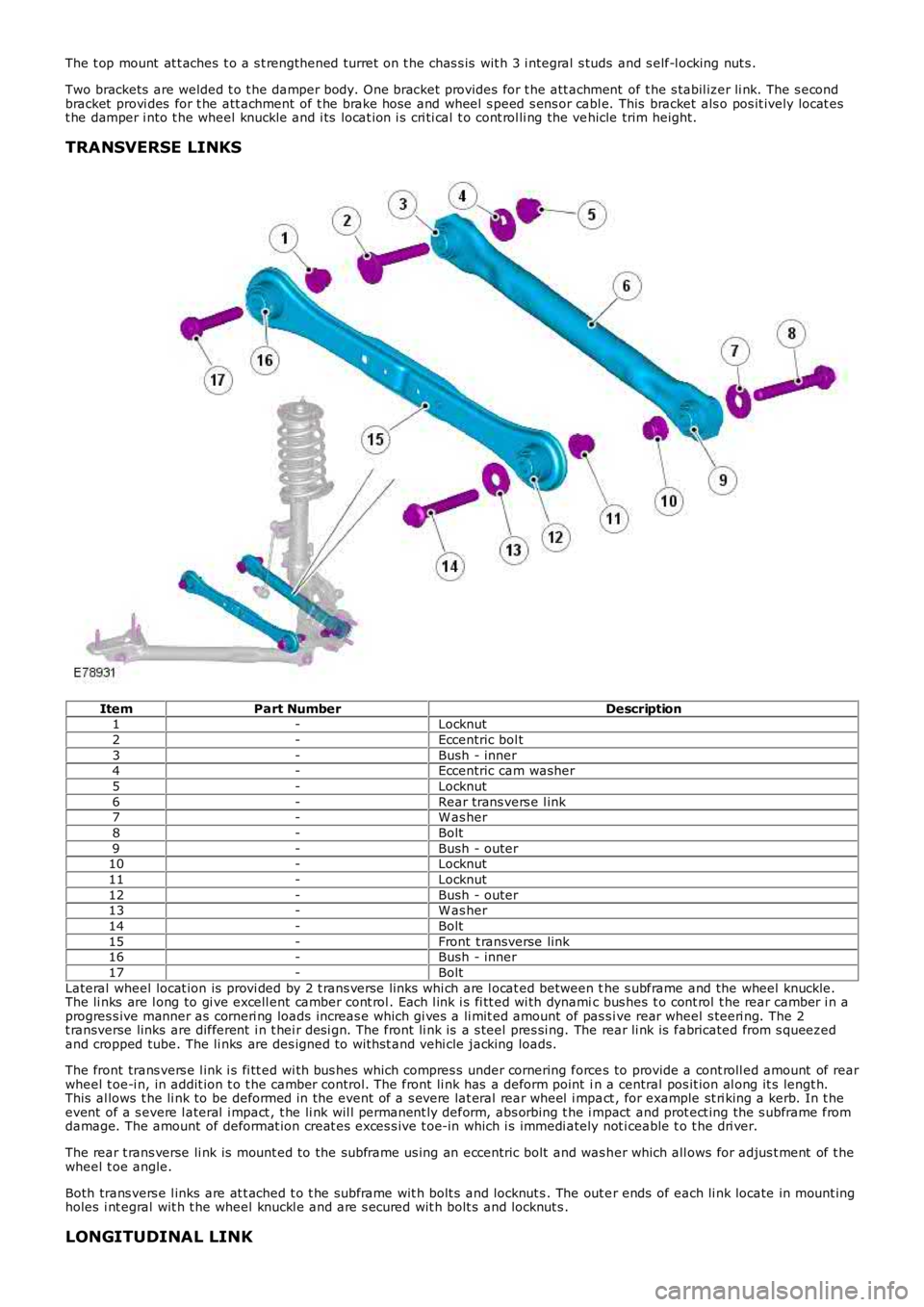
The t op mount at t aches t o a s t rengthened turret on t he chas s is wit h 3 i ntegral s tuds and s elf-l ocking nut s .
Two brackets are welded t o t he damper body. One bracket provides for t he att achment of t he s tabil izer li nk. The s econdbracket provi des for t he att achment of t he brake hose and wheel s peed s ens or cabl e. This bracket als o pos it ively locat est he damper i nto t he wheel knuckle and i ts locat ion i s cri ti cal t o cont rol li ng the vehicle trim height.
TRANSVERSE LINKS
ItemPart NumberDescription1-Locknut
2-Eccentric bol t
3-Bush - inner4-Eccentric cam washer
5-Locknut
6-Rear trans vers e l ink7-W as her
8-Bolt
9-Bush - outer10-Locknut
11-Locknut
12-Bush - outer13-W as her
14-Bolt
15-Front t ransverse link16-Bush - inner
17-Bolt
Lateral wheel locat ion is provi ded by 2 t rans verse li nks whi ch are l ocat ed between the s ubframe and the wheel knuckle.The li nks are l ong to gi ve excell ent camber cont rol . Each l ink i s fi tt ed wi th dynamic bus hes t o cont rol t he rear camber i n aprogres s ive manner as corneri ng loads increas e which gi ves a li mit ed amount of pas s ive rear wheel s teeri ng. The 2t ransverse links are different i n t hei r des i gn. The front li nk is a s teel pres si ng. The rear li nk is fabricated from s queezedand cropped tube. The li nks are des igned to wit hst and vehi cle jacking loads.
The front trans vers e l ink i s fi tt ed wi th bus hes which compres s under cornering forces to provide a cont roll ed amount of rearwheel t oe-i n, in addit ion t o t he camber control. The front li nk has a deform point in a central pos it ion al ong it s lengt h.This al lows t he li nk to be deformed in the event of a s evere lat eral rear wheel i mpact , for example st ri king a kerb. In t heevent of a s evere l ateral i mpact , t he li nk wil l permanent ly deform, abs orbing t he i mpact and prot ect ing the s ubframe fromdamage. The amount of deformat ion creat es exces s ive t oe-in which i s immedi ately not iceable t o t he dri ver.
The rear t rans verse li nk is mount ed to the subframe us ing an eccentric bolt and was her which all ows for adjus t ment of t hewheel t oe angle.
Both trans vers e l inks are at t ached t o t he s ubframe wit h bolt s and locknut s . The out er ends of each li nk locate in mount ingholes i nt egral wit h t he wheel knuckl e and are s ecured wit h bolt s and locknut s .
LONGITUDINAL LINK
Page 234 of 3229
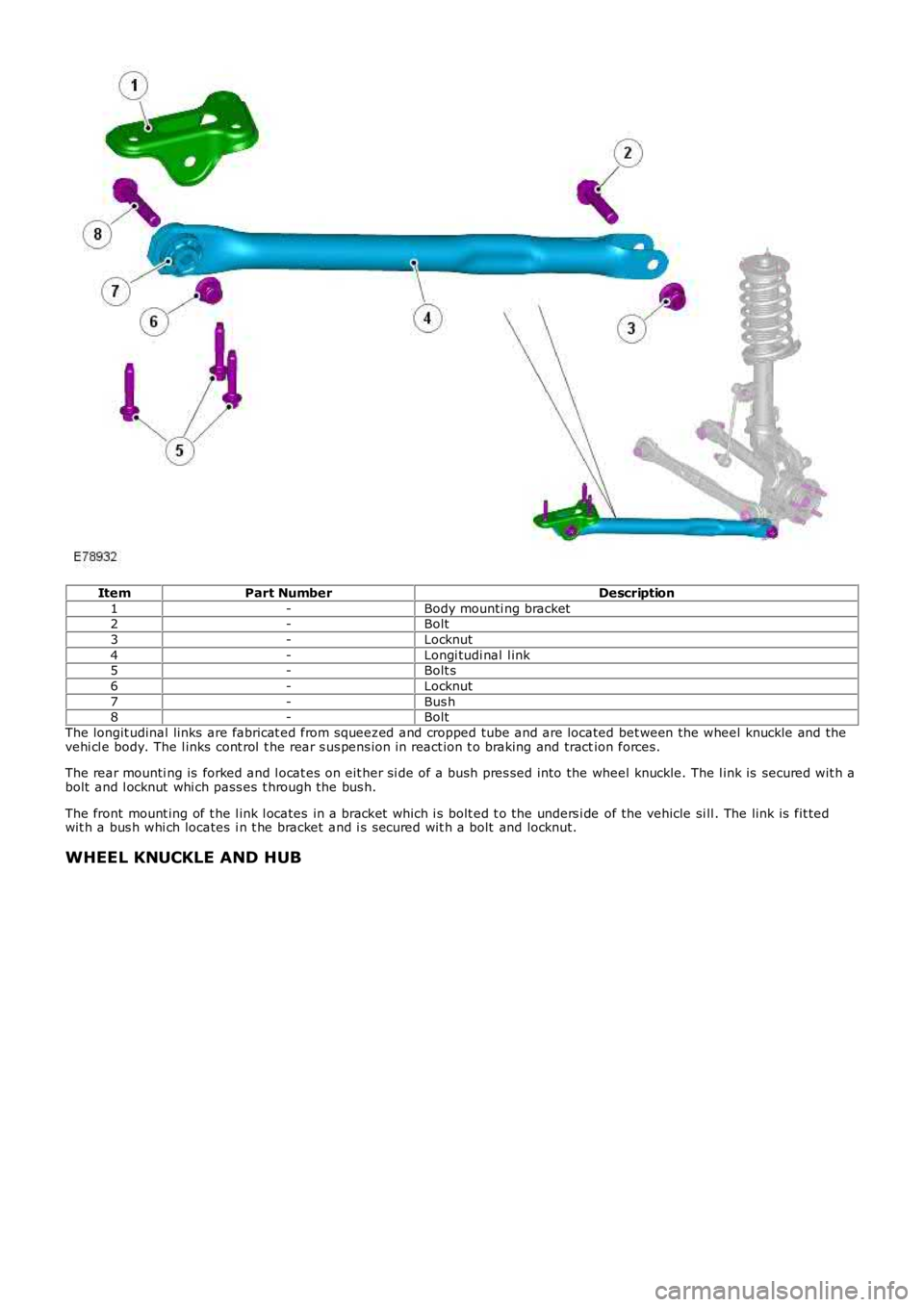
ItemPart NumberDescription
1-Body mounti ng bracket2-Bolt
3-Locknut
4-Longi tudi nal l ink5-Bolt s
6-Locknut
7-Bus h8-Bolt
The longit udinal links are fabricat ed from s queezed and cropped tube and are located bet ween the wheel knuckle and thevehi cl e body. The l inks cont rol t he rear s us pens ion i n react ion t o braking and traction forces.
The rear mounti ng is forked and l ocat es on eit her si de of a bush pres sed into the wheel knuckle. The l ink is secured wit h abolt and l ocknut whi ch pass es t hrough the bus h.
The front mount ing of t he l ink l ocates in a bracket which i s bolt ed t o the unders i de of the vehicle si ll . The link is fit tedwit h a bus h whi ch locates i n t he bracket and i s s ecured wit h a bolt and locknut.
WHEEL KNUCKLE AND HUB
Page 235 of 3229
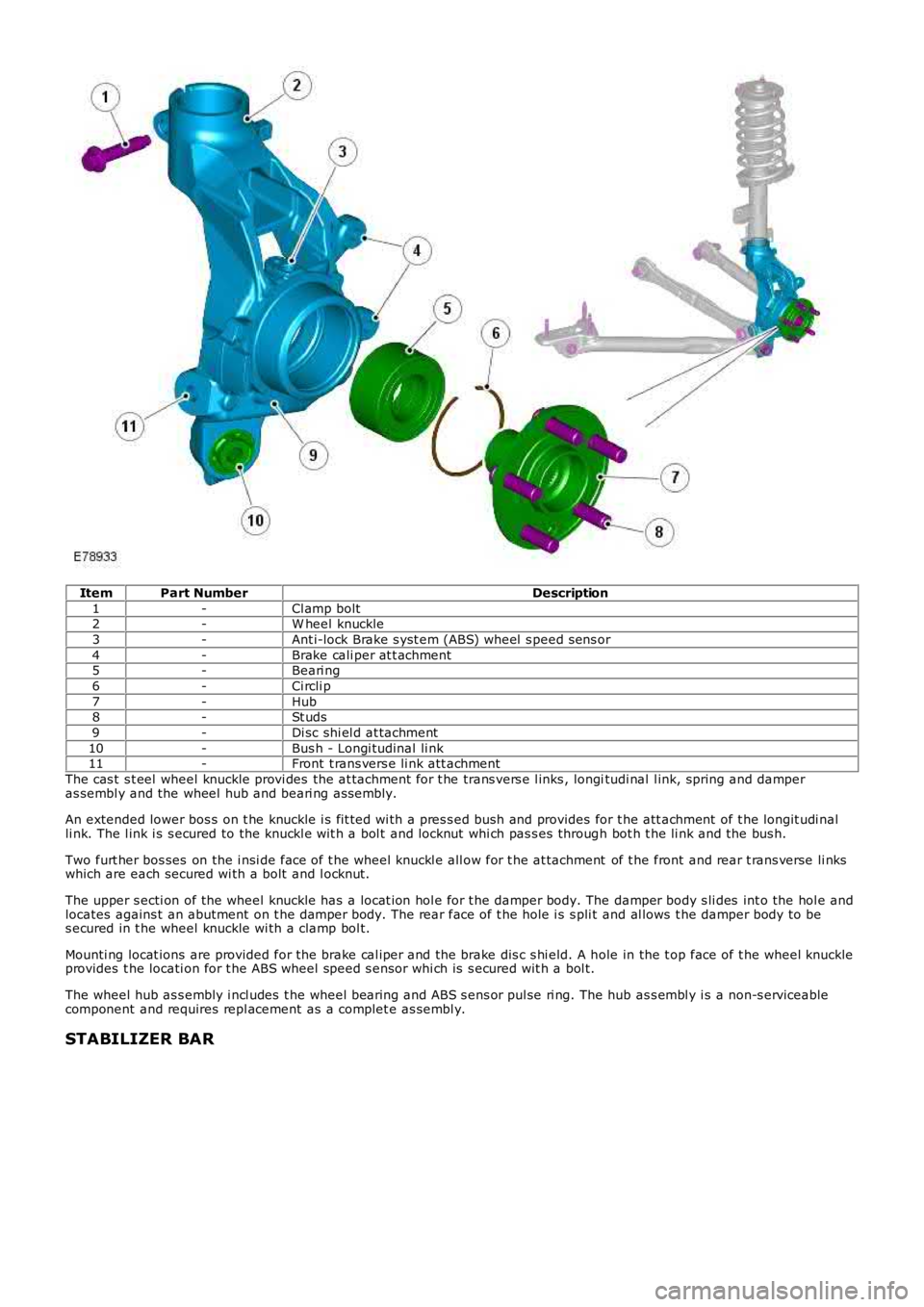
ItemPart NumberDescription
1-Cl amp bolt2-W heel knuckle
3-Ant i-lock Brake s yst em (ABS) wheel s peed s ens or
4-Brake cali per at t achment5-Beari ng
6-Ci rcli p
7-Hub8-St uds
9-Di sc shi el d at tachment
10-Bus h - Longi tudinal li nk11-Front t rans vers e li nk att achment
The cas t s t eel wheel knuckle provi des the at tachment for t he trans vers e l inks , longitudi nal l ink, spring and damperas sembl y and the wheel hub and beari ng ass embly.
An extended lower bos s on t he knuckle i s fit ted wi th a pres s ed bush and provides for t he att achment of t he longit udi nalli nk. The l ink i s s ecured to the knuckl e wit h a bol t and locknut whi ch pas s es through bot h t he li nk and the bus h.
Two furt her bos ses on the i nsi de face of t he wheel knuckl e all ow for t he at tachment of t he front and rear t rans verse li nkswhich are each secured wi th a bolt and l ocknut.
The upper s ecti on of the wheel knuckle has a locat ion hol e for t he damper body. The damper body s li des int o the hol e andlocates agains t an abutment on t he damper body. The rear face of t he hole i s s pli t and al lows t he damper body to bes ecured in t he wheel knuckle wi th a clamp bol t.
Mounti ng locat ions are provided for the brake cal iper and the brake dis c s hi eld. A hole in the t op face of t he wheel knuckl eprovides t he locati on for t he ABS wheel speed s ensor whi ch is s ecured wit h a bol t.
The wheel hub as s embly i ncl udes t he wheel bearing and ABS s ens or pul se ri ng. The hub as s embl y i s a non-s erviceablecomponent and requires repl acement as a complet e as sembl y.
STABILIZER BAR
Page 236 of 3229
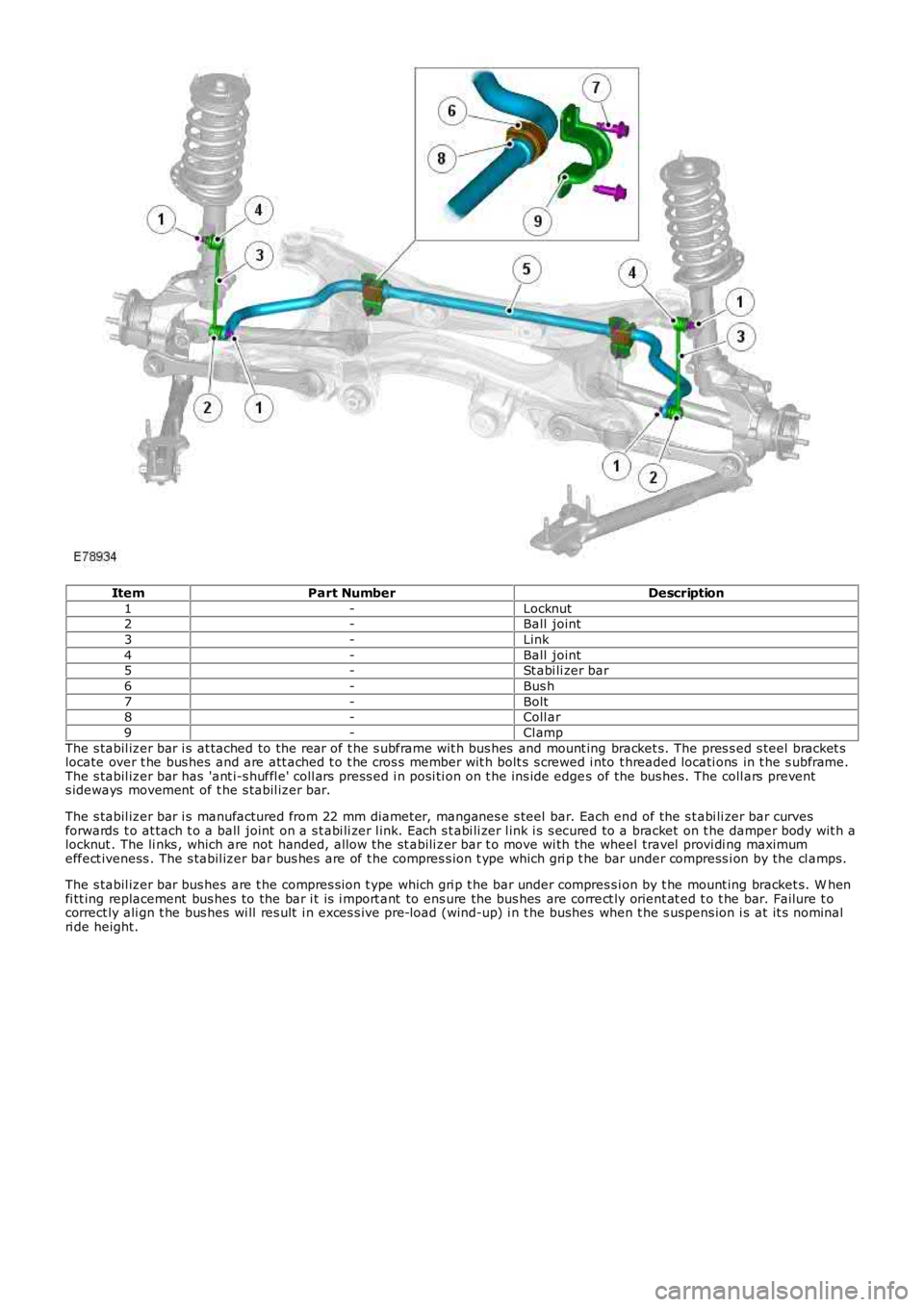
ItemPart NumberDescription
1-Locknut2-Ball joint
3-Link
4-Ball joint5-St abi li zer bar
6-Bus h
7-Bolt8-Coll ar
9-Cl amp
The s tabil izer bar i s at tached to the rear of t he s ubframe wit h bus hes and mount ing bracket s. The pres s ed s teel bracket slocate over t he bus hes and are att ached t o t he cros s member wit h bolt s s crewed i nto t hreaded locati ons in t he s ubframe.The s tabil izer bar has 'ant i-s huffl e' coll ars press ed i n posi ti on on t he ins ide edges of the bus hes. The coll ars prevents ideways movement of t he s tabil izer bar.
The s tabil izer bar i s manufactured from 22 mm diameter, manganes e s teel bar. Each end of the s t abi li zer bar curvesforwards t o at tach t o a ball joint on a s t abi li zer l ink. Each s t abi li zer l ink i s s ecured to a bracket on t he damper body wit h alocknut . The li nks , which are not handed, allow the st abili zer bar t o move wi th the wheel travel provi di ng maximumeffect iveness . The s tabil izer bar bus hes are of t he compres s ion t ype which gri p t he bar under compress i on by the cl amps.
The s tabil izer bar bus hes are t he compres s ion t ype which gri p t he bar under compres si on by t he mount ing bracket s. W henfi tt ing replacement bus hes to the bar i t is i mport ant to ens ure the bus hes are correct ly orient at ed t o t he bar. Failure t ocorrect ly ali gn t he bus hes wi ll res ult i n exces s ive pre-load (wind-up) i n t he bushes when t he s uspens ion i s at it s nominalri de height.
Page 274 of 3229
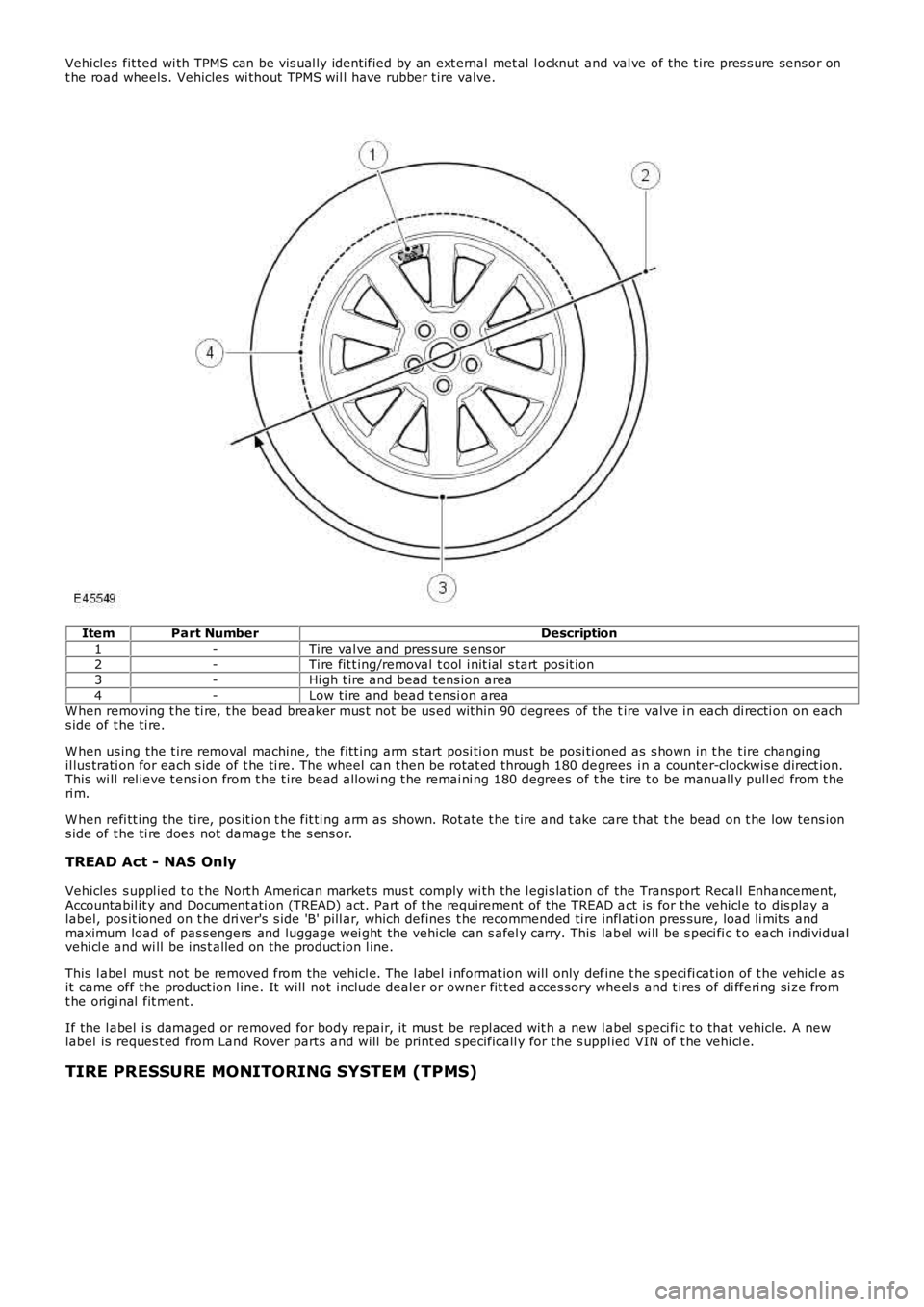
Vehicles fit ted wi th TPMS can be vis ual ly ident ified by an ext ernal met al l ocknut and val ve of the t ire pres s ure sens or ont he road wheels . Vehicles wi thout TPMS wil l have rubber t ire valve.
ItemPart NumberDescription
1-Ti re val ve and pres sure s ens or
2-Ti re fit t ing/removal t ool i nit ial s tart pos it ion3-Hi gh t ire and bead tens ion area
4-Low ti re and bead t ensi on area
W hen removing t he ti re, t he bead breaker mus t not be us ed wit hin 90 degrees of the tire valve i n each di recti on on eachs ide of t he ti re.
W hen us ing the t ire removal machine, the fit t ing arm s t art posi ti on mus t be posi ti oned as s hown in t he t ire changingil lus trati on for each s ide of t he ti re. The wheel can t hen be rotat ed through 180 degrees i n a counter-clockwis e direct ion.This wi ll rel ieve t ens i on from t he t ire bead allowi ng t he remai ni ng 180 degrees of the t ire t o be manuall y pull ed from t heri m.
W hen refi tt ing t he t ire, pos it ion t he fit ti ng arm as s hown. Rot ate t he t ire and t ake care that t he bead on t he low tens ions ide of t he ti re does not damage t he s ens or.
TREAD Act - NAS Only
Vehicles s uppl ied t o t he Nort h American market s mus t comply wi th the l egi s lati on of the Transport Recall Enhancement,Accountabil it y and Document ati on (TREAD) act. Part of t he requirement of the TREAD act is for the vehicl e to dis play alabel, pos it ioned on t he dri ver's s ide 'B' pill ar, which defines t he recommended ti re infl ati on pres sure, load li mit s andmaximum load of pas sengers and luggage wei ght the vehicle can s afel y carry. This label wi ll be s peci fi c t o each individualvehi cl e and wi ll be i ns t alled on the product ion l ine.
This l abel mus t not be removed from the vehicl e. The l abel i nformat ion will only define t he s peci fi cat ion of t he vehi cl e asit came off the product ion l ine. It will not include dealer or owner fit t ed acces sory wheel s and t ires of di fferi ng si ze fromt he origi nal fit ment.
If the l abel i s damaged or removed for body repair, it mus t be repl aced wit h a new label s peci fi c t o that vehicle. A newlabel is reques t ed from Land Rover parts and will be print ed s pecificall y for t he s uppl ied VIN of t he vehi cl e.
TIRE PRESSURE MONITORING SYSTEM (TPMS)
Page 294 of 3229
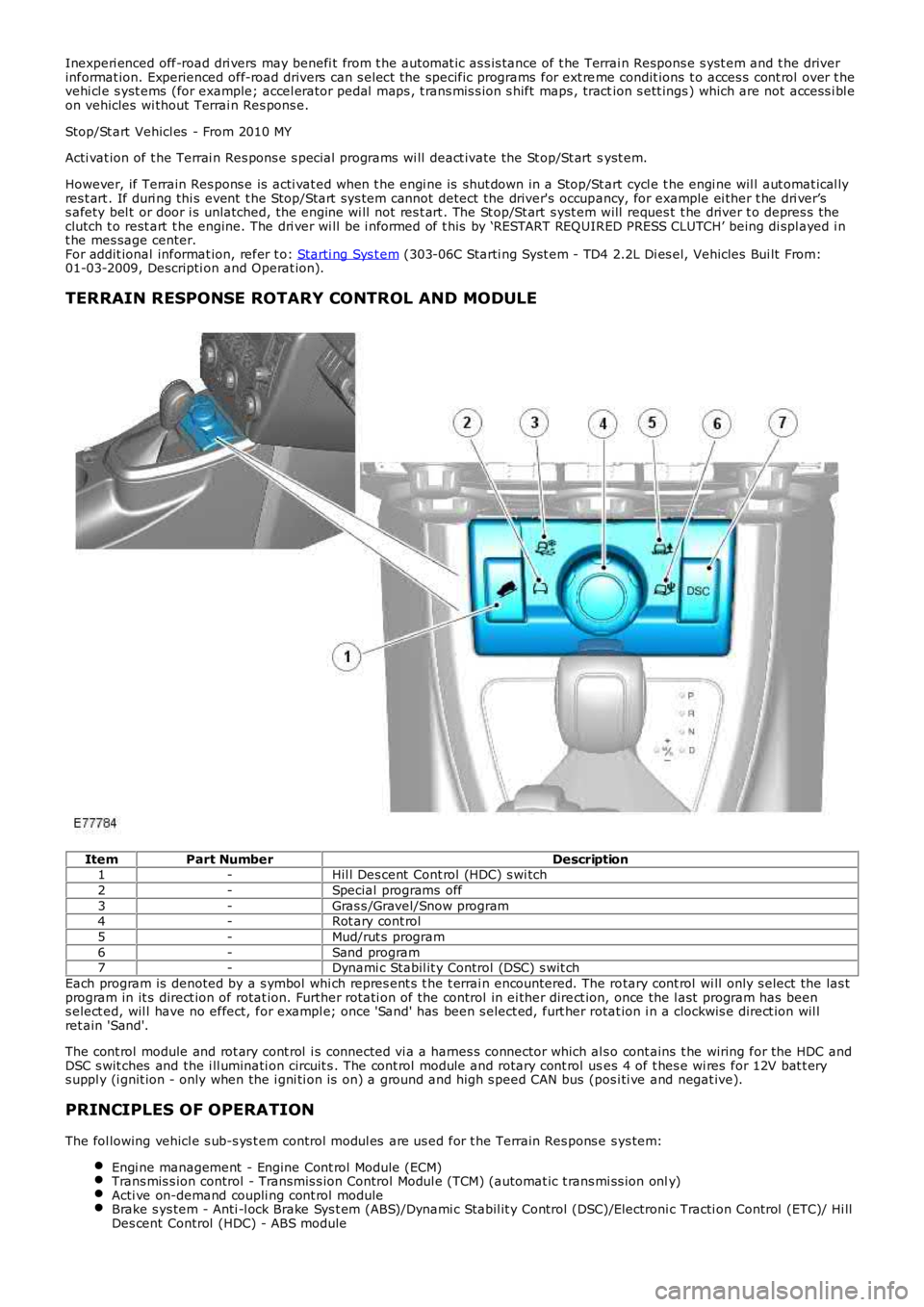
Inexperi enced off-road dri vers may benefi t from t he automat ic as s is tance of t he Terrai n Respons e s yst em and t he driverinformat ion. Experienced off-road drivers can s elect the specific programs for ext reme condit ions t o acces s cont rol over t hevehi cl e s yst ems (for example; accel erator pedal maps , t rans mis s ion s hift maps , traction s ett ings ) which are not access i bl eon vehicles wi thout Terrai n Res pons e.
Stop/St art Vehicl es - From 2010 MY
Acti vat ion of t he Terrai n Res pons e s peci al programs wi ll deact ivate the St op/St art syst em.
However, if Terrain Res pons e is acti vat ed when t he engi ne is shut down in a Stop/St art cycl e t he engi ne wil l aut omat ical lyres t art . If duri ng thi s event t he Stop/Start sys tem cannot detect the driver's occupancy, for example ei ther t he dri ver’ss afety bel t or door i s unlatched, the engine wi ll not res t art . The St op/St art s yst em will reques t t he driver t o depres s theclutch t o rest art t he engine. The dri ver wi ll be i nformed of t his by ‘RESTART REQUIRED PRESS CLUTCH’ being di spl ayed i nt he mes sage center.For addit ional informat ion, refer t o: Starti ng Sys t em (303-06C Starti ng Syst em - TD4 2.2L Di es el, Vehicles Bui lt From:01-03-2009, Descripti on and Operat ion).
TERRAIN RESPONSE ROTARY CONTROL AND MODULE
ItemPart NumberDescription1-Hil l Des cent Cont rol (HDC) s wi tch
2-Special programs off
3-Gras s /Gravel/Snow program4-Rot ary cont rol
5-Mud/rut s program
6-Sand program7-Dynami c Stabil it y Control (DSC) s wit ch
Each program is denoted by a s ymbol whi ch repres ent s t he t errai n encountered. The rotary cont rol wi ll only s elect the las tprogram in it s direct ion of rotat ion. Further rot ati on of the control in ei ther direct ion, once the l ast program has beens elect ed, wil l have no effect, for exampl e; once 'Sand' has been s elect ed, furt her rotat ion i n a clockwis e direct ion wil lret ain 'Sand'.
The cont rol module and rot ary cont rol i s connected vi a a harnes s connector which al so cont ains t he wiring for the HDC andDSC s wit ches and the i ll uminati on circuit s . The cont rol module and rotary cont rol uses 4 of t hes e wi res for 12V bat t erys uppl y (i gnit ion - only when the i gni ti on is on) a ground and high s peed CAN bus (pos i ti ve and negat ive).
PRINCIPLES OF OPERATION
The fol lowing vehicl e s ub-s ys t em control modul es are us ed for t he Terrain Res pons e sys tem:
Engi ne management - Engine Cont rol Module (ECM)Trans mis s ion control - Transmis s ion Control Modul e (TCM) (automat ic t rans mi ss ion only)Acti ve on-demand coupli ng cont rol moduleBrake s ys tem - Anti -l ock Brake Sys t em (ABS)/Dynami c Stabil it y Control (DSC)/Electroni c Tracti on Control (ETC)/ Hi llDes cent Control (HDC) - ABS module
Page 295 of 3229
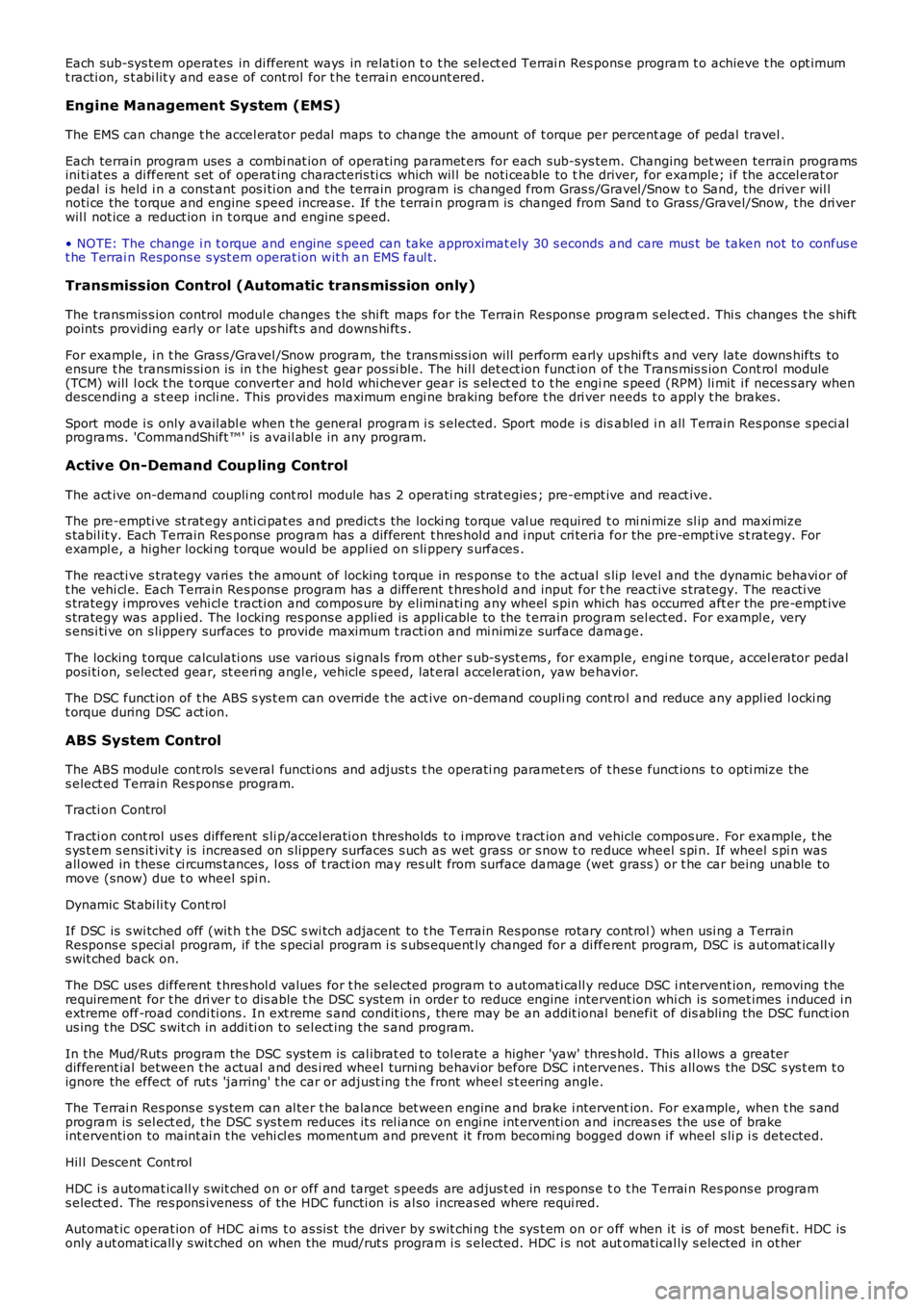
Each sub-sys tem operates in di fferent ways in relati on t o t he sel ect ed Terrai n Res pons e program t o achieve t he opt imumt racti on, s t abi lit y and eas e of cont rol for t he t errai n encount ered.
Engine Management System (EMS)
The EMS can change t he accel erator pedal maps to change the amount of t orque per percent age of pedal travel .
Each terrain program uses a combi nat ion of operat ing paramet ers for each sub-sys tem. Changing bet ween terrain programsini ti at es a di fferent s et of operat ing characteris ti cs which wil l be noti ceable to the driver, for example; i f the accel erat orpedal i s held i n a const ant pos i ti on and the terrain program is changed from Gras s /Gravel /Snow t o Sand, the driver wil lnoti ce the t orque and engine s peed increas e. If t he t errai n program is changed from Sand t o Grass /Gravel/Snow, t he dri verwil l not ice a reduct ion in t orque and engine s peed.
• NOTE: The change i n t orque and engine s peed can take approximat ely 30 s econds and care mus t be taken not to confus et he Terrai n Respons e s yst em operat ion wit h an EMS faul t.
Transmission Control (Automatic transmission only)
The t ransmis s ion control modul e changes t he shi ft maps for the Terrain Respons e program s elect ed. Thi s changes t he s hi ftpoints providing early or l at e ups hift s and downs hi ft s .
For example, i n t he Gras s /Gravel /Snow program, the trans mi ss i on wil l perform early ups hi ft s and very late downs hifts toensure t he transmis si on is in t he highes t gear pos si ble. The hil l det ect ion funct ion of t he Trans mis s ion Cont rol module(TCM) will l ock t he t orque converter and hold whi chever gear i s s el ect ed t o t he engine s peed (RPM) li mit i f neces s ary whendescending a s t eep incli ne. This provi des maximum engi ne braking before t he dri ver needs t o appl y t he brakes.
Sport mode i s only avail abl e when t he general program i s s elected. Sport mode i s disabled i n all Terrain Res pons e s peci alprograms. 'CommandShift ™' is avail abl e in any program.
Active On-Demand Coup ling Control
The act ive on-demand coupli ng cont rol module has 2 operati ng s trat egies ; pre-empt ive and react ive.
The pre-empti ve st rat egy anti ci pat es and predict s the locki ng torque val ue required t o mi ni mi ze sl ip and maxi mizes tabil it y. Each Terrain Res pons e program has a different t hres hol d and i nput cri teria for the pre-empt ive s t rategy. Forexampl e, a higher locki ng t orque would be appl ied on s li ppery s urfaces .
The reacti ve s trategy vari es the amount of locking t orque in res pons e t o t he actual s lip level and t he dynamic behavi or oft he vehi cl e. Each Terrain Res pons e program has a different t hres hol d and input for the react ive s trategy. The reacti ves trategy i mproves vehi cl e t racti on and compos ure by eliminati ng any wheel s pin which has occurred aft er the pre-empt ives trategy was appli ed. The l ocking res pons e appli ed is appli cable to the t errain program sel ect ed. For exampl e, verys ens i ti ve on s lippery surfaces to provide maximum t racti on and mi nimi ze surface damage.
The locking t orque calculati ons use various s ignals from other s ub-s yst ems , for example, engi ne torque, accel erator pedalposi ti on, s elect ed gear, st eeri ng angl e, vehicle s peed, lat eral accelerat ion, yaw behavi or.
The DSC funct ion of t he ABS s ys t em can override t he act ive on-demand coupli ng cont rol and reduce any appl ied l ocki ngt orque during DSC act ion.
ABS System Control
The ABS module cont rols several functi ons and adjust s t he operati ng paramet ers of t hes e funct ions t o opti mize thes elect ed Terrain Res pons e program.
Tracti on Control
Tracti on cont rol us es different s li p/accel erati on thresholds to i mprove t ract ion and vehicle compos ure. For example, t hes ys t em s ens it ivit y is increased on s lippery surfaces s uch as wet grass or s now t o reduce wheel s pi n. If wheel s pi n wasall owed in t hese ci rcums tances, l oss of t ract ion may res ul t from surface damage (wet grass ) or t he car being unable tomove (snow) due t o wheel spi n.
Dynamic St abi li ty Cont rol
If DSC is s wi tched off (wit h t he DSC s wi tch adjacent to t he Terrain Res pons e rotary cont rol ) when usi ng a TerrainRespons e s peci al program, if t he s peci al program i s s ubs equent ly changed for a di fferent program, DSC is aut omat icall ys wit ched back on.
The DSC us es different t hres hol d values for t he s elected program t o aut omati call y reduce DSC i ntervent ion, removing t herequirement for t he dri ver t o dis able t he DSC s ys tem in order to reduce engine intervent ion whi ch is s omet imes i nduced i nextreme off-road condi ti ons . In ext reme s and condit ions , there may be an addit ional benefit of dis abling the DSC funct ionus ing t he DSC s wit ch in addi ti on to sel ect ing t he s and program.
In the Mud/Ruts program the DSC sys tem is cal ibrat ed t o tol erate a higher 'yaw' thres hold. This al lows a greaterdifferent ial between t he actual and des i red wheel turni ng behavi or before DSC i ntervenes . Thi s all ows the DSC s ys t em t oignore the effect of rut s 'jarring' t he car or adjust ing t he front wheel s t eering angle.
The Terrai n Res pons e s ys tem can al ter t he balance bet ween engine and brake i ntervention. For example, when t he s andprogram is sel ect ed, t he DSC s ys tem reduces it s rel iance on engi ne int erventi on and increas es the us e of brakeint erventi on to maint ai n t he vehi cl es momentum and prevent it from becomi ng bogged down i f wheel s li p i s detected.
Hil l Descent Cont rol
HDC i s automat icall y s wit ched on or off and target s peeds are adjus t ed in res pons e to t he Terrai n Res pons e programs elect ed. The res pons iveness of the HDC functi on is al so increas ed where requi red.
Automat ic operat ion of HDC ai ms t o as s is t the driver by s wit chi ng t he sys t em on or off when it is of most benefi t. HDC isonly aut omat icall y s wit ched on when the mud/rut s program i s s elect ed. HDC i s not automati cal ly s elected in ot her